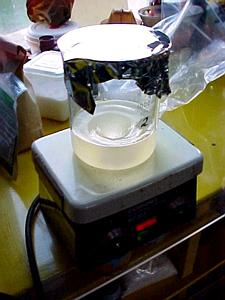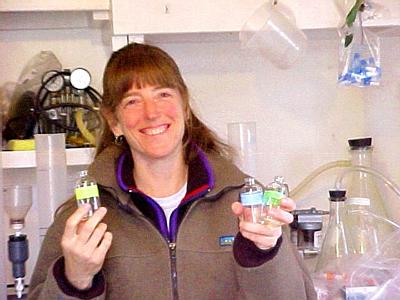29 November, 1999
Science in the Kitchen
As you know from reading the description of the research near the top of my
web page, one component of the research at Lake Bonney is to culture the
organisms we are pulling out of the lake in our water column samples. If
you can get them to grow, you can control the amount of organisms you have
to use in further experiments. Given the right temperature, light and
nutrient conditions that simulate their natural environment, you can keep
cultures around for a long time, even years.
To grow bacteria, viruses and phytoplankton, you need to come up with the
perfect, nutritious "meal" for the organisms to feed on. This is called the
"culture medium". The right medium provides an environment that stimulates
these one-celled organisms to reproduce by cell division. Once they start
dividing, each half divides again and before you know it, you've gone from
one cell to thousands. This is exactly what the two Johns and Jack want.
Lots of new cells. But first, they've got to find the recipe for that
perfect medium.
Like making any new recipe and serving it to a large family of finicky
eaters, you never know for sure who's going to like what. If you really
want your family to eat, you may end up deciding to prepare a smorgasbord
so everyone can pick and choose their favorite. Of course, making so many
types of food for one meal would get tiring, fast. Fortunately, unlike
phytoplankton, picky family members can make their own meals if they don't
like what's being served.
Well, mixing culture medium is sort of like trying to please that difficult
family. Not only are you searching for the perfect meal full of all the
right ingredients, you hope the meal will be palatable. The organisms have
got to want to eat, or you'll end up disappointed, with a petri dish of
dehydrating agar and some miniscule dying cells languishing on the surface.
John L. and Barb have been making batches of powdered culture medium in the
tiny 6'x 10' lab next to the Jamesway. Since the recipes tend to make huge
batches of medium, and they only needed a fraction of the amount, they had
to re-calculate everything using complex algebraic formulas. This was very
time consuming. Once they had their new proportions, they were ready to get
into the chemicals. When the powders were thoroughly mixed, they added
de-ionized water to make a liquid medium. They put the jars of medium in
the pressure cooker and steamed them sterile. By the time they were done,
they had a number of different recipes to try the organisms out on. They'll
feast the same type of organisms on a variety of media. It'll be the big
phytoplankton "taste test" to see which they prefer.

There are times when scientific projects are not able to be conducted in the most ideal conditions. Wrong equipment, missing chemicals, non-sterile environment... Sometimes you have to improvise- especially when you're working in the field. When it came time to heat up the medium and mix it with agar (a substance like clear jello used for thickening), Barb and John moved right into the kitchen, where they diligently kept their phyto food out of our human meal. Here, John is warning the mix it better start boiling.

The container of medium is boiling away on the hot plate. John placed a small ceramic rod in the bottom of the container. When the medium heated up, the rod started spinning and created a waterspout, which helped mix all the liquid ingredients together.

You need to have a steady hand to pour the boiling liquid into the petri dishes.

Each of the petri dishes were labeled with the type of media they contain. Then, they were set aside to thicken as they cool. Once they cool, they'll provide a growth surface where John can smear cells from the water samples. The dishes will be covered and set in an incubator at McMurdo. All that's left to do is after that will be patient waiting and fervent hope.

I don't have any formal training in chemistry. Given the biochemical nature of the research being conducted here at Lake Bonney, I'm unable to do any of the analytical work that is the core of the research. But, I do have terrific handwriting. I found my chemistry-assistant calling when I got to label the collection bottles for this Wednesday's trip to Lake Fryxell.

The antidote to Antarctic color deprivation.
Contact the TEA in the field at
.
If you cannot connect through your browser, copy the
TEA's e-mail address in the "To:" line of
your favorite e-mail package.
|
